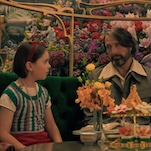Amer

Fans of Italian giallo maestro Dario Argento understand that part of appreciating his singularly ornate and operatic visual setpieces is tolerating the stretches where characters explain, at great length and in dubious accent, what’s causing all that mayhem. An extended homage to Argento, Mario Bava, and other practitioners of the genre, Hélène Cattet and Bruno Forzani’s transfixing semi-experimental feature Amer seeks to strip all that exposition away and limit the focus exclusively to sound and image. There’s probably a page or two’s worth of dialogue in the script, and even that is clipped or deliberately obscured, never coalescing in anything that could ever be described as a conversation. What’s left is, unsurprisingly, abstract and hard to comprehend, but also staggeringly beautiful, an assemblage of suggestive images and sounds that carry the violence, sensuality, and terror of giallo without being explicit about what they mean.








































